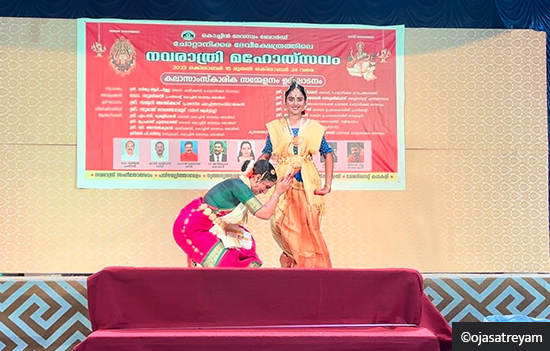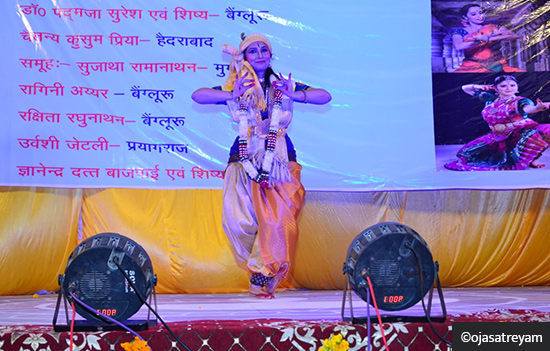- Ojas, a budding
Bharatanatyam (BN) artist, tells you what attracted her to BN, compares learning
of BN in USA & India, why did she return to Bharat for training, challenges
faced in run up to her Arangetram & message for aspiring students of Indian
dance forms.
Synopsis
Ojas, a young management student and budding Bharatanatyam artist speaks about her journey from being a NRI child growing up in U.S.A. to her return to India to forge a deeper connect with her roots and to pursue Bharatanatyam in its most traditional guru-shishya parampara. Ojas’s journey is reminiscent of an increasing number of young Indians, who are proud ambassadors of their rich civilisational legacy and are well-poised to take it forward.
1.
What or who inspired you to take up training in a Bharatiya classical
dance-form?
My first
inspiration to take up traditional Bharatanatyam training came from my mother,
who not only sowed the seeds of interest for performing arts in me, but also channelized
my basic aptitude in dance towards our classical Bharatiya dance-form of
Bharatanatyam.
Though living in
the U.S, I come from a household steeped in day-to-day practice of the
Bharatiya way of life. This paved the way for both me and my younger brother,
who has taken up the study of Vedas in a traditional Veda Paathashaala in
India, to appreciate and feel invested in the richness of our heritage and
cultural legacy.
My mother took the initiative of enrolling me for Bharatanatyam lessons with my first Guru in the US in Shrewsbury, Massachusetts and I have not looked back since then. Watching senior students dance would motivate and intrigue me. Any hesitation I may have had as a child to take up this art-form disappeared once I began my dance lessons. I am also grateful to my Math teacher - “Gopi Bhaiyya”, as we would call him, for encouraging me to take up Bharatanatyam seriously.
2.
Of the many Indian dance forms, why did you choose Bharatanatyam?
Hailing from a
traditional Tamil family, Bharatanatyam and Carnatic music are inherent to our
cultural milieu, leading to a natural inclination towards this particular
dance-form. Once I began formal training in Bharatanatyam, I was fortunate and
blessed to have found my true calling in this beautiful art-form.
3.
What was your experience learning Bharatanatyam in the US?
My initial
training in Bharatanatyam happened in my hometown, Shrewsbury, Massachusetts. I
am grateful to my first Guru, Smt. Sapna Krishnan, for not only nurturing my
fledgling interest in dancing into a passionate pursuit, but also imparting
strong fundamentals in the art-form that has helped during my continuing
training in India.
 Author and Aarya Bharadwaj performing at the Chottanikkara Bhagavathy Temple in Kochi, Kerala
Author and Aarya Bharadwaj performing at the Chottanikkara Bhagavathy Temple in Kochi, Kerala
4.
Why was it important to return to India to continue your training?
When I decided
to take up Bharatanatyam as a career, rather than just as a pursuit of an
extracurricular interest, my parents felt that I should have an opportunity to
learn, as much as possible, in the traditional Guru-Shishya parampara with in-depth understanding of Natyashastra. They wanted me to experience a rounded and structured approach to learning the dance-form and acquire the right attitude towards ‘sadhana’ or perseverance towards building proficiency in the art-form.
Training in
India has given me the opportunity to study traditional banis (styles) in their most authentic formats and in great detail. I am currently training in the Thanjavur Bani, which is known for its equal blend of ‘lokadharmi’ style of ‘Abhinaya’ featuring realistic and natural expressions and fluidity, and ‘natyadharmi’ style of ‘Abhinaya’ featuring a more dramatical approach to expressions. I have also been exposed to the Kalakshetra Bani, which is well-known for its linearity, geometry and crispness.
My journey back
to India to learn Bharatanatyam has also made me understand that nuances of the
art, the intent and format of certain unique choreographies and the connection
formed by the artist with the art, all become deep and meaningful while
learning happens in the original geographical and traditional contexts.
 Ojas performing at Ayodhya in March 2023.
Ojas performing at Ayodhya in March 2023.
5.
What are the major highlights of your learning experience in India?
Learning
Bharatanatyam in India is a deeply immersive experience. It is not only the
learning environment but also the understanding of how the art-form is deeply
embedded in the socio-cultural fabric of the country.
Learning of the origin and history including ‘slokas’ from authentic sources add immense value to conceptual understanding of the ‘shastra’ and the ‘shastric drishti’ towards Bharatiya
classical dances. Astute students of classical dances in India have
multi-dimensional opportunities of learning the antiquity of tradition from
temple architecture, sculpture and carvings that brilliantly showcase these
dance-forms and their nuances.
In addition,
experiencing festivals in India (which include meeting and learning from some
of the greatest exponents of the art) that are connected deeply to art such as
the Margazhi Maasam (Margazhi month) between mid-December and
mid-January esp. in the city of Chennai, helps explore various facets of the
dance-form.
All these experiences go a long way in nurturing ‘sadhana’ or perseverance in artists and enable a complete understanding of what every performance entails.
I truly feel
that these experiences in their original regional, spiritual and emotional
contexts cannot be replicated elsewhere.
6.
What are the benefits of one-to-one engagement with the Guru?
A one-on-one
engagement between the Guru and Shishya is imperative for the student to acquire the subtle aspects and features of a certain distinct format of expression of the dance-form. In addition, the outlook and ‘bhaava’ of an artist also reflects the approach of the Guru. What the
student learns is much more than just how to perform. Reverence and respect for
the Guru leads to the appreciation of the ‘sacred’ inherent in both Natya
(dance-form) and the Shastra
(Science).
I am fortunate
to have had the opportunity to work very closely, almost like a shadow, with my
Guru, Dr. Padmaja Suresh including accompanying her when she travelled for her
performances and lectures. This way, not only was I privy to her creative
thinking process but also to the values and ideals that her Gurus imbibed in
her, which she generously imparted to all her students. Being part of a
Guru-Shishya parampara has enabled me to appreciate values such as humility,
respect and devotion towards all aspects of the art-form including the artists,
who serve the art with immense dedication.
7. What kind of challenges did you face in the run up to ‘Arangetram’and how did you overcome these?
‘Arangetram’ means ‘ascending the stage’ and represents the solo-performance debut of a dance-student. It is the dream of every aspiring dancer to graduate to the ‘Arangetram’ after years of learning and practice. It was a grueling process. When the practice for the Arangetram
began, I was both excited and nervous.
I must admit
that continuous repetitions required while practising were challenging, tedious
and frustrating as by nature, I am a very spontaneous person and usually prefer
diverse activities. Not only that but the minute corrections my Guru made, required me to work on every
segment of the performance at home, even after long sessions at the
dance-class. This combined with my college studies left me with very little
time for anything else.
Each ‘jathi’ and its ‘mukthaiyam’ were practised separately. And once perfected all the
components were put together in a cohesive flow. As a student, I was also
frustrated about being unable to meet my Guru’s expectations at certain times and that prompted additional hours of practice both at class and home. The support of family and friends is crucial during this time.
The other key
challenge is dealing with physical injuries from time to time. I went through
my share of injuries (many of these I did not tell my Guru about) including a muscle injury in my shoulder and a knee
injury. During the last two months of practice, I was wearing two ankle braces.
It was only after the ‘Arangetram’ that I fully comprehended every detail my Guru had
corrected and insisted upon.
I believe that complete faith in my Guru helped me pull through the process of preparation and is the main reason for the successful completion of my ‘Arangetram’.
 Glimpses from Ojas’s Arangetram.
Glimpses from Ojas’s Arangetram.
8.
What are some of the negative trends that you have observed in this space?
Bharatanatyam is a classical dance-form with its own well-defined framework. I believe that creating ‘fusion’ versions that are not true to the essence of Bharatanatyam does not add any value to the performances. This is, especially, as it does not do justice to the inherent ‘bhaava’ of the art-form that connects the artist with the art and with the audiences.
However,
meaningful interventions that are both respectful to the core of Natyashastra
and relevant to the art are required for its natural progression over time.
9. What is your message for fellow youngsters, who may want to take up this art-form in India and overseas?
Learning
classical art-forms such as Bharatanatyam, Kathak, Odissi or any other such
performing art is a beautiful way for us to connect with our rich cultural heritage.
I would urge
aspiring dancers to go beyond learning the performance aspects of these
dance-forms and take up a more immersive approach for a richer experience.
Also read
1. Introduction to
Bharatanatyam
2. Bharata’s Natya Sastra
3. Peruvian
Bharatantyam dancer
4. Significance of
Mudras in Indian Classical Dance
5. Four
Basic Elements of Carnatic Music
6. Padma
Shri Awardee, Vidushi Aruna Sairamji enlightens on key differences between
Hindustani and Carnatic Classical Music.
To read all
articles on Indian Dance Forms